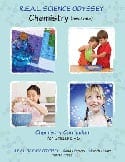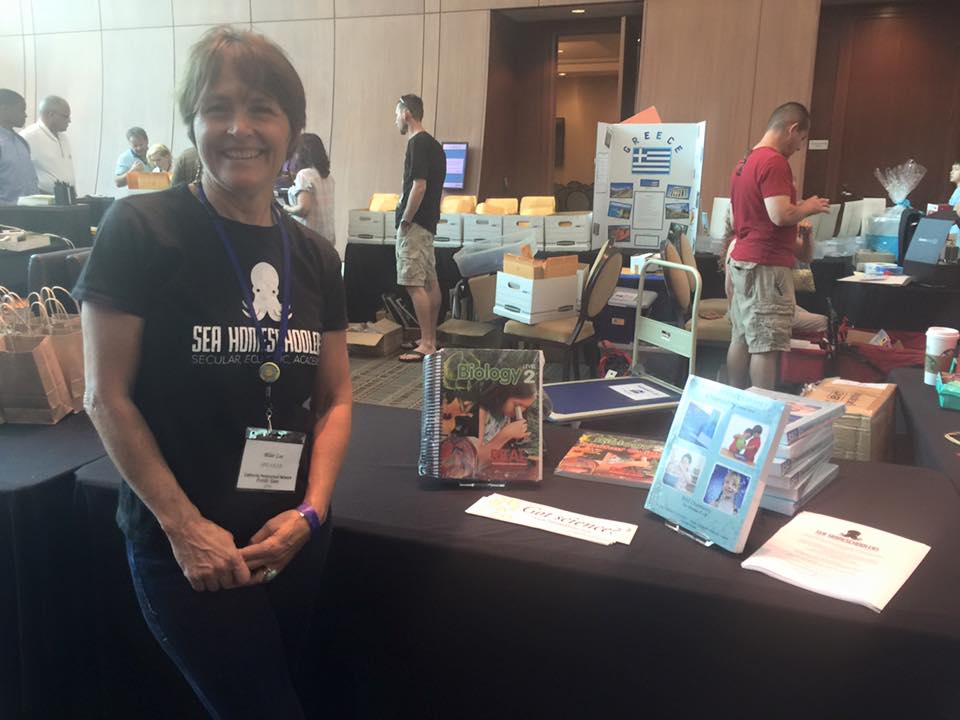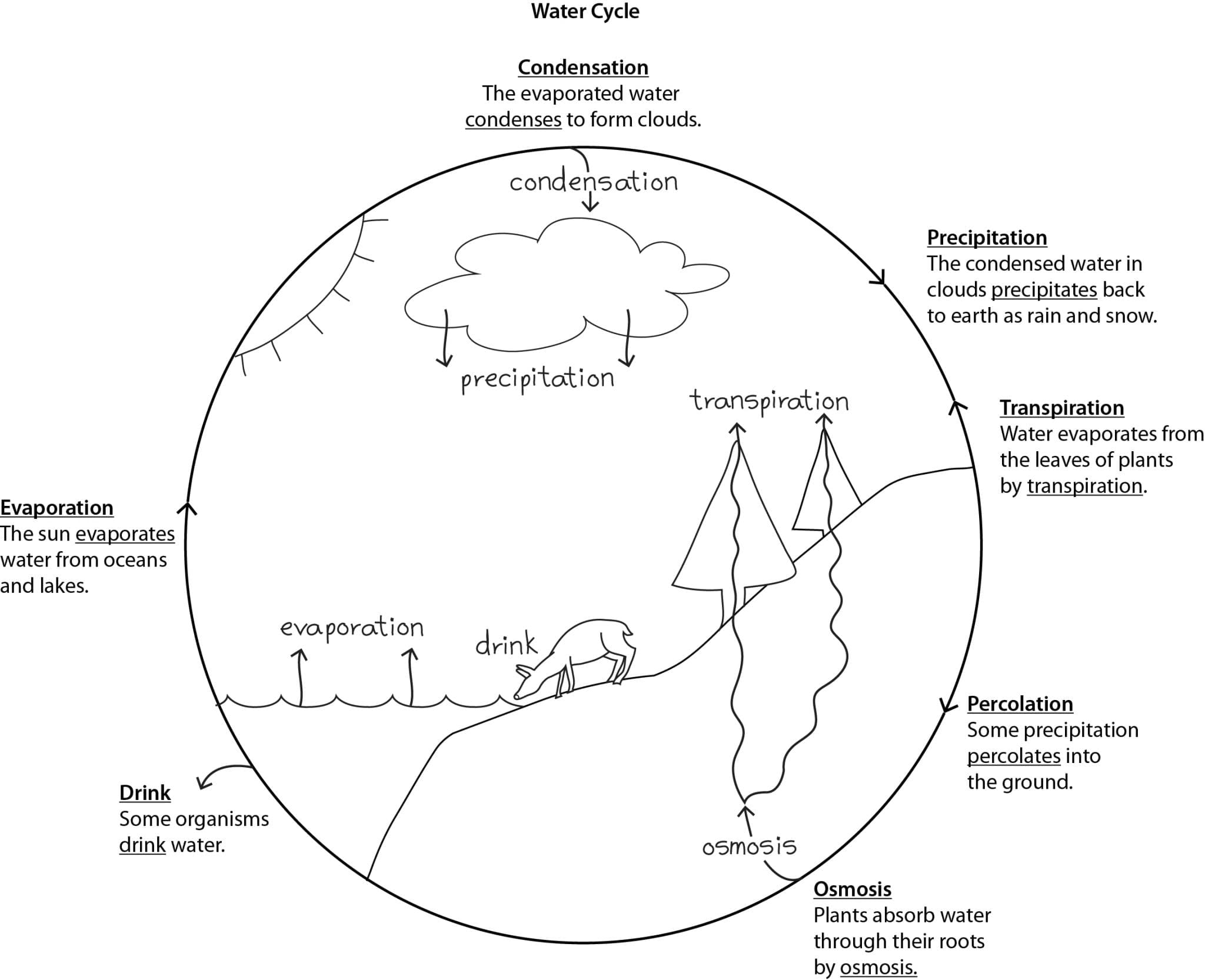REAL Science Odyssey Chemistry 1 is a great choice for a science co-op, however because it was designed to be done 2 days a week it presents some scheduling challenges when conducting the labs in 1 day. You might want to teach this class 2 days per week, if you do, follow the format in the book as laid out on pages 14 – 16 of RSO Chemistry 1. If you don’t, some weeks will require parents to do work at home. This schedule is for doing the class 1 day per week.

Note: The page numbers below are for the written text. If you have an e-book these page numbers will be a little off. Refer to the schedule in the book if there is any confusion about page numbers.
For more general information about teaching a science co-op read my blog article, Using REAL Science Odyssey for a Homeschool Co-op: General Notes.
Unless noted I recommend the following format for your class each week:
In class
- Read the theory
- Conduct the lab
At Home
- Crossword Puzzle, when there is one
- Some assignments and projects, as indicated below
For more general information about teaching a science co-op read my blog article, Using REAL Science Odyssey for a Homeschool Co-op: General Notes.
Unless noted I recommend the following format for your class each week:
In class
- Read the theory
- Conduct the lab
At Home
- Crossword Puzzle, when there is one
- Some assignments and projects, as indicated below
Week 1
The first week of class can be a bit hectic. I suggest you divide the week up this way
In class: Lab #2 pages 27 – 30
*** It is very important you go over the process you are using when conducting this lab. Discuss the scientific method, what it means, and how it is being applied.
At home: Lab #1 and the crossword puzzle pages 23 – 25, 31
Week 2
Each week discuss the parts to the scientific method. These are on the lab sheets for most labs. By the end of the year you want students to be fluent in the vocabulary used when applying the scientific method.
Lab #1 pages 37 – 39
Lab #2 pages 43 – 44
Week 3
At home: Read over pages 46 – 47 and Make Parts poster page 47
In class:
- Do the Parts! Lab: 49 – 51 next week
- Types! Lab: pages 54 – 61, There will be plenty of time for students to do this individually, but you could have students work on this together, so that the entire class makes this on a large table building one element at a time. If you do, make sure everyone participates (maybe put the labels in a hat and have students choose one, and make that element when it is his or her turn; if you have more than 10 students have students work in pairs for the larger elements like neon).
Week 4
There is a lot of sitting around today so I would suggest breaking it up by
- Read pages 66 – 67
- Do Parts! Lab: 49 – 51: Have an extra balloon for each student to take home, so they can share this demonstration with their family. Ask students to teach their family what is happening in this experiment.
- Do The Alphabet Lab #1 pages 69 – 73: Work through this methodically with your students. Students will be using this periodic table for several more chapters DO NOT let them take it home!!!
Have student do pages 75 – 79 at home, unless you have time at the end of class in which case have them do page 75 in class
Week 5
There are three parts to the Atomic Numbers section
- Atomic Numbers Lab #1 can be done as a demonstration or individually it is up to you
- While you wait the 20 minutes for the final observation for Lab #1: Read over page 81 and have students fill in the atomic numbers section on their periodic table.
- Atomic Numbers Lab #2 start in class, if students don’t finish it have them finish it at home
Week 6
In class:
- Read over pages 95 – 96 and have students fill in the assigned section on their periodic table
- Do Massive Matters Lab #2
At home: Massive Matters Lab #1
Week 7
- Read over page 105 and have students fill in the assigned section on their periodic table
- Do the Lab, page 111
- Save the worksheet page 109 for last in case you need to have students do it at home
Week 8
In class:
- Read over page 113 – 115 and have students fill in the atomic numbers section on their periodic table
- Do Lab 119 – 122; take your time with this lab. It is a really good one
At home: page 117
Week 9
The lab on page 129 – 131 requires an oven. If this is a problem for you:
- Fill in worksheet pages 125 – 127
- Have students (with parental supervision) do the lab at home and bring the muffins in for a tasting party. If you do this have student mix in berries or chocolate chips (assign this individually) so you have some variation in the muffins.
- You should have completed periodic tables to put on walls or desks for students to show off to their parents. This is the end of Unit 3, so it is a good place to take the time to do this.
Week 10
Over the next 9 weeks students will be creating a book for the first three rows of the periodic table going across by group. There is some drawing to be done each week. Class time for this can be problematic because some students will take 5 minutes to do the same task another student take 55 minutes on.
Each week for the next 8 weeks: Read over the For My Notebook page and make notes about the elements in the spaces on the pages for the Element Book.
I will give you my advice each week, but you might need to tweak it.
- Recruit 1 or a group of parents to do the work on pages 139 – 140 for each student
This week In class:
- Read page 136: have students follow along on their periodic table
- Fill out page 137 and glue it to their book. Do not let students take this home.
- Read page 141: have students fill in the Facts section on page 149. This and every other week, have students work on the rest of the page at home.
- Do Lab page 143 – 145
- Read page 142: have students fill in the Facts section on page 151. This and every other week, have students work on the rest of the page at home.
Week 11
The Lab for this week< Crystal Creation, is short and will not be completed until next week. Students should be able to do all the work for their Element Book including decorating it in class.
Week 12
- Make observations for the Crystal Creation Lab page 157.
- Expect a fun mess with the lab today! Save some of this for week 26. It will stay good if you refrigerate it.
- Students should be able to do all the work for their Element Book in class. If they cannot have students complete the pages at home.
Week 13
- Students should be able to do all the work for their Element Book in class. If they cannot have students complete the pages at home.
- The lab requires an oven. Try to round up a toaster oven if you need to. This lab is fun and yummy.
Week 14
- Students should be able to do all the work for their Element Book in class. If they cannot have students complete the pages at home.
- The lab requires an oven and a mixer. A toaster oven will work.
Week 15
- Students should be able to do all the work for their Element Book in class. If they cannot have students complete the pages at home.
- There are 2 labs for this week.
- The lab on page 193 requires a heat source. Have students do it at home if that is a problem. A toaster oven will not work.
- Do the lab on pages 195 – 197
Week 16
- Students should be able to do all the work for their Element Book in class. If they cannot have students complete the pages at home.
- There are 2 labs for this week.
- Lab #1 needs to be done as a demonstration. Bleach is too toxic and caustic to risk having a group of students use it.
- You will start Lab #2 today and finish it next week. There are a few changes to the procedure so that this lab can be done by all the students. Change the procedure instructions for Procedure 8 in the book to Let the egg sit for 7 full days. Do not refrigerate the egg. Have students make the vinegar solution in a double baggie. If the egg breaks and leaks out of the baggies it will be badly stinky!!! Have students take the baggied egg home and complete the experiment at home the next day. Have them share their observations at the start of next week’s class.
Week 17
Students should be able to do all the work for their Element Book in class. If they cannot have students complete the pages at home. You might even be able to put the books together. If you do not have a refrigerator in class, use an ice chest with ice in it. Perform the experiment while working on the Element Books. Have a balloon for each student to celebrate the end of the unit or just use 1. If you have a balloon for each student, have everyone put their balloon in the cold source at the same time so all the cold air does not get out from being opened repeatedly.
Week 18
There are 3 labs/activities this week. The Lab on page 243 – 245 will be done at the start of next week.
- The puzzle pages 233 – 235: You might want to have 1 set of pieces per student pre-cut. If you do consider asking parents or students to bring these pre-cut pieces with them to class.
- Lab #1 pages 239 – 241
Week 19
- Begin class with the lab page 251, set a timer for 1 hour and make the second observation. I am not sure if this experiment will last over a week. You are going to need to check on it after 24 hours, and take a photo. Then you can wait a week and see. That way your students can use your photo as the final observation if they have to.
- Lab page 243 – 245
- Worksheet page 249
Week 20
- Lab 261 – 264
- Have students finish today with the worksheet page 255 – 259. They can complete this at home if you run out of time.
Week 21
- Have student complete the poem at home.
- Start class with Activity #1 on pages 269 and 271
- Have student share poems if they are so inclined.
- Have students do Activity #2 on pages 269 – 270 and 273
Week 22
Do pages 275 – 279
Week 23
- Do pages 281 – 289: Use a microwave if you have to in order to boil water. An electric tea kettle will also work.
- Have the ingredients for Jell-o present, but make a batch of Jell-o ahead of time so students can make observations about the Jell-O in class.
Week 24
Do pages 291 – 300: You have a group of students so why not use them for a density demonstrations. Mark off a space on the ground that will just fit all the students standing as a group. Have the students fill the space 1 by 1. Have the students move around in the marked off area. This will show them how much less space there is to move when more particles (people) occupy the same amount of space.
Week 25
Take a look at the lab on pages 303 to 305. The amount of set up time is perfect. But the lab takes 1 week to complete and you make a hot sugary solution. It is a good lab though.
You have a group: do the group activity on page 304
Week 26
Do pages 307 – 315: Use the slime you saved
Week 27
Do page 317 – 325: To do the lab on page 319 in 1 lab period. Use 3 bottles. Take one bottle and freeze it with the cap off the day before class. Bring the bottle to class, but take a photo in case it starts to melt before class starts. Suggest students put a bottle with the cap off with a dish under it in the freezer overnight to observe the expansion of water for themselves.
Week 28
Pages 327 to 337: There are three activities/labs this week. You should be able to get through them all. You will need a microwave and 1 or more kites. If it isn’t windy, the kite is optional.
Week 29
Pages 339 – 347
Week 30
Pages 353 – 361: You will need pre-frozen Kool-Aid
Week 31
Pages 363 – 371
Week 32
Pages 373 – 379: The indicator should be made at home. Do Step 1 at home and bring the indicator to class. Have kids make the coffee filter pH paper from Step 1 in class. They will use it next week.
Week 33
Pages 381 – 387
Week 34
Pages 389 – 397
Week 35
Pages 399 – 403: Have students make the solution for Day 1. You are going to need to make the same solution the day before so you can do the entire experiment in 1 day. Have students take the solution home in a baggie so they can see the results for their own solution. Alternatively, you could leave it a week and have students make their observations next week.
Week 36
Pages 405 – 411
Read about using RSO Biology 2 here.



